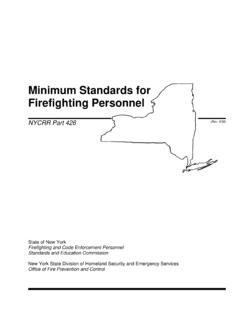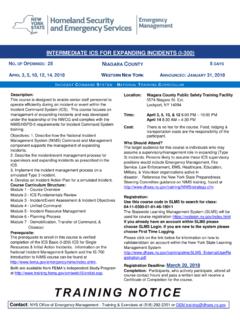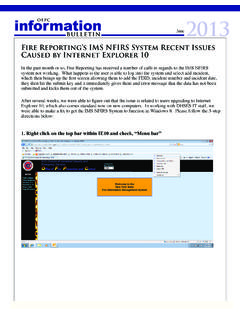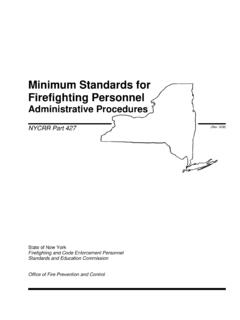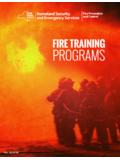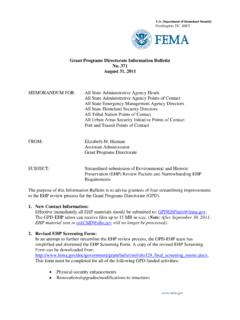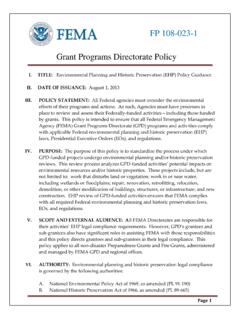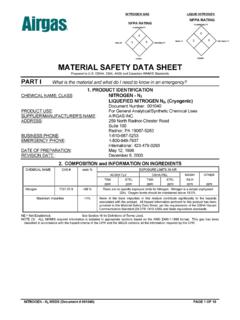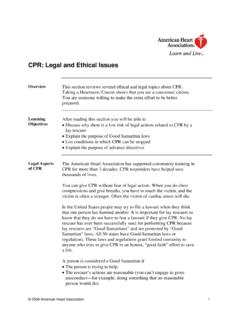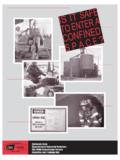Transcription of Water Rescue Awareness Level - New York
1 Water Rescue Awareness Level Student Manual Technical Rescue 01-04-0052 (12/07). Fire Prevention Academy of and Control Fire Science Fire Prevention and Control W elcome to the New York State Fire Training Program Water Rescue - Awareness Level The Division of Homeland Security and Emergency Services recognizes that providing training for paid and volunteer firefighters and related officials is an important part of the services it makes available. Our Office of Fire Prevention and Control (OFPC) places a very high priority on training because we believe it is essential for the men and women of the fire and emergency services in New York State. The Office of Fire Prevention and Control's programs include the most complete progression of training available today -- beginning with probationary firefighters and extending the full length of a firefighter's career with the fire service. While our training programs address specific fire and arson prevention and control issues, we also encourage expansion and improvement of local training facilities and programs in cooperation with fire companies, municipal corporations and districts.
2 This course provides an overview of Water safety and Rescue issues including: hazard assessment, responder safety, risk management, hypothermia, near-drowning, basic Water search techniques, basic shore-based Rescue techniques, incident management issues, and Water Rescue equipment. Your comments and suggestions about this student manual, our training classes or any OFPC. program are always welcome. Your input will help us build on our successes and make needed changes, when appropriate. On behalf of the citizens you serve, we want you to know that your participation and commitment are greatly appreciated. Albany, NY 12210-2833. phone: (518) 474-6746 fax: (518) 474-3240 e-mail: web: New York State Office of Fire Prevention and Control Water Rescue - Awareness Level . ACKNOWLEDGMENTS. The preparation of this course was made possible through the assistance, cooperation and dedication of many people. The Department of State's Office of Fire Prevention and Control wishes to thank the following persons for their role in the development of this course.
3 Principle Development Group George Bassler, Fire Protection Specialist I, NYS OFPC. David O. Simmons, SFI - Delaware County Dell Jeffery, NYS Forest Rangers Brian Rousseau, Deputy Chief, NYS OFPC. Associated Contributors and Reviewers Steve Disick, Albany Fire Department Willis Sheldon, Ithaca Fire Department Chris Reed, West Point Fire Department Tony Santulli, Albany Fire Department Diana Robinson, NYS Academy of Fire Science Pennsylvania Fish Commission Rescue 3 International December 2007 Water Rescue Awareness Level i New York State Office of Fire Prevention and Control ii Water Rescue Safety Awareness Level December 2007. New York State Office of Fire Prevention and Control TABLE OF CONTENTS. Unit 1 - Introduction to Water Rescue Course Overview & Objectives 3. Introduction to Water Rescue 5. Water Hazards & The Dynamics of Moving 9. Medical Considerations for Water Rescue 16. Unit 2 - Water Rescue Equipment, Techniques and Incident Management Self Rescue & PPE 21.
4 Shore Based and Advanced Rescue Techniques.. 25. Water Rescue Incident Management 29. Appendix Swift Water Accident Reports 33. Five Ways to Survive a Swift Water Rescue 41. New Flood Rescue Response Model 45. Sample Water Rescue Incident Action Plan . 51. Sample Water Rescue Hazard Assessment .. 53. Water Rescue Awareness Level Pre-test 55. Water Rescue Size Up Exercise Worksheet 57. December 2007 Water Rescue Awareness Level iii New York State Office of Fire Prevention and Control iv Water Rescue Safety Awareness Level December 2007. New York State Office of Fire Prevention and Control Unit 1. Introduction to Water Rescue December 2007 Water Rescue Awareness Level 1. New York State Office of Fire Prevention and Control 2 Water Rescue Safety Awareness Level December 2007. New York State Office of Fire Prevention and Control Course Overview and Objectives Course Overview The Water Rescue Safety and Awareness course is part of a series of courses designed to develop and enhance your skills as a rescuer.
5 These programs are delivered both in the field and as residential offerings at the New York State Academy of Fire Science to allow you the opportunity to continue your education and training as a rescuer. This course is designed to introduce Firefighters and EMS personnel to Water Rescue at the Awareness Level of response. The course is an informational only course with no hands on training, it is not intended to provide instruction in Water Rescue skills. To be able to perform Water rescues, personal should obtain hands on training such the Water Rescue Operations or Swift- Water Technician Level courses. Course Objectives The overall objective of this course is to enhance the safety of the first responders at Water Rescue incidents by increasing their knowlegde of the hazards of Water Rescue and the techniques and equipment needed to manage those hazards. At the completion of this course the student shall have: An Awareness of the risks in Water incidents The ability to recognize hazards at Water incidents Knowledge of the NYS Water Rescue training program The ability to identify local Water Rescue resources Knowledge of basic shore based Rescue techniques Knowledge of Water Rescue equipment An Awareness of the risks in Water incidents December 2007 Water Rescue Awareness Level 3.
6 New York State Office of Fire Prevention and Control The 4 hour Water Rescue Awareness Level course consists of 2 units of instruction covering the following subjects: Unit 1 Introduction to Water Rescue Lesson registration, Introduction and Overview Lesson - Introduction to Water Rescue Lesson - Water Hazards & the Dynamics of Moving Water Lesson - Medical Considerations for Water Rescue Unit 2 - Water Rescue Equipment, Techniques and Incident Management Lesson Self Rescue & PPE. Lesson Shore Based and Advanced Rescue Techniques Lesson Water Rescue Incident Management Course Safety Objectives Identify the personal protective equipment needed for Water Rescue operations. Gain an understanding of the safe use of the specialized equipment used in Water Rescue operations. Identify procedures for performing a scene size-up to identify and control hazards, making the Rescue area safe. Gain an understanding of the importance of redundancy in Water Rescue systems and operations.
7 Safety Guidelines This course is intended to provide first responders with knowledge needed for safe operations at Water Rescue incidents. It is not intended to train responders in Water Rescue skills. To master the skills needed for Water Rescue requires hands on practical skill training including self- Rescue and Rescue techniques. Attempting rescues or Rescue practice, without adequate training, may result in death or injury to personnel.. 4 Water Rescue Safety Awareness Level December 2007. New York State Office of Fire Prevention and Control Introduction to Water Rescue Water Rescue incidents can happen in any jurisdiction. These are infrequent but extremely high risk incidents. Due the infrequent nature of these events most departments do not spend much time training or equipping their personnel to handle Water rescues. However the hazardous nature of these incidents can place firefighters at extreme risk with rescuers often becoming victims themselves, further complicating the incident.
8 Drowning Facts Second leading cause of accidental death in 4000 lives lost annually in US/300,000. worldwide Over half of victims are children Almost all victims failed to wear a PFD. Alcohol and hypothermia are often contributing factors Many would be rescuers become victims themselves Water Rescue incidents can be caused by many Water Rescue Incidents different events and occur in many different locations, Recreational Accidents Transportation Accidents from backyard pools to rivers and lakes. Even normally small streams can become swollen torrents in flood conditions. Flooding may involve multiple victims and Flooding Water Searches extended operations. Flash floods often create Water Rescue incidents at sites with no normal Water hazards. Transportation accidents involving Water Rescue can These incidents can happen almost anywhere, is your dept ready for NYS Office of Fire Prevention & Control for a Water Rescue ? happen without warning and generate multiple victims.
9 Water Searches often involve only one or two victims, but bring large number of rescuers to the scene often with little training or equipment. December 2007 Water Rescue Awareness Level 5. New York State Office of Fire Prevention and Control Because Water rescues are infrequent events, firefighters often lack even basic training in Water Rescue . However, as in most technical Rescue incidents, it is the Fire Department that is called on to respond when these events do occur. occur. While departments with high numbers of Water related calls are often well trained for Water rescues, floods can create Water Rescue problems in virtually any location, so all emergency response agencies should have some Level of training and equipment for Water Rescue . Most successful Water rescues are made by first arriving units. The special hazards of Water Rescue put the untrained & unequipped rescuer at an extreme high risk. Unlike most technical Rescue incidents, in Water Rescue often there is no time to wait for a specialized team to respond.
10 Flooding causes more deaths per year then any natural disaster and many of the deaths are would be rescuers often in locations with little normal Water hazards. The Risk Paradox illustrated below shows the relation of hazard Level and frequency to risk. Events such as structure fires & motor vehicle accidents are frequent events for firefighters and as such we develop recognition based decision making skills which allow us to mitigate the high hazards which they present. However, at events which are low frequency, we do not have a chance to build the Level of competence needed to overcome the hazards. In addition, at some events we will have time to plan how to deal with the hazards, but the urgent nature of Water Rescue often does not give us this opportunity. Frequency of Incidents HIGH LOW. L. O EMS CALLS WILDLAND SEARCHES. H w A. Z. A H. R I. D G STRUCTURE FIRES Water Rescue . H. S. 6 Water Rescue Safety Awareness Level December 2007. New York State Office of Fire Prevention and Control Rescuers often drown because of a lack of understanding of the risks involved in Water Rescue and over estimating their skills or abilities.
